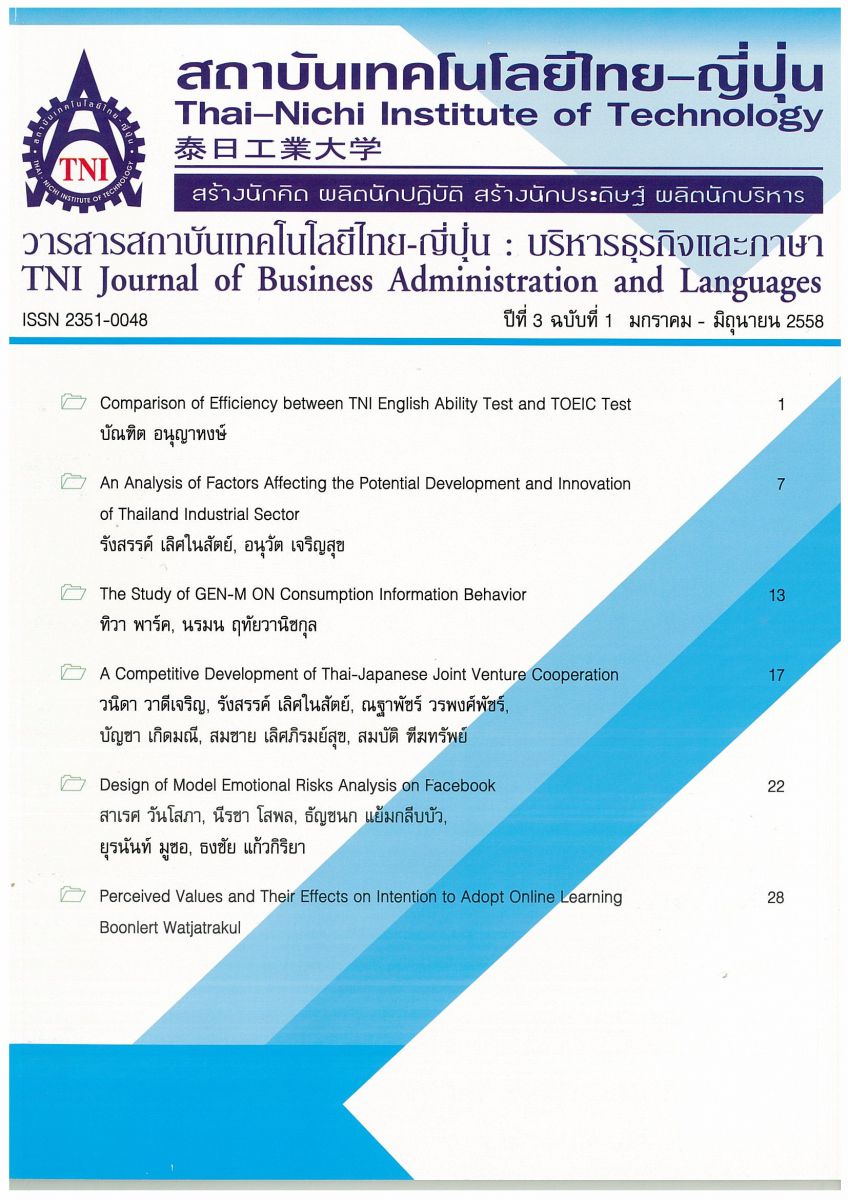Perceived Values and Their Effects on Intention to Adopt Online Learning
Main Article Content
บทคัดย่อ
The concept of perceived value and its effect on technology adoption has received much attention in information systems literature. The value dimensions of theory of consumption value, however, has less focus among IS researchers. The study applies the theory’s value dimensions-functional (quality and monetary values), emotional, social, epistemic, and conditional values to understand their interrelationships and effects on students’ intentions to adopt online learning. The structural equation modelling analysis technique is used to investigate the research model. The results show that conditional value plays an important role to influence students’ intentions to adopt online learning through other values. Emotional and social values have direct effects on intention to adopt online learning. The study extends the knowledge on technology adoption and provides guidance for universities to improve their online learning services to be more valuable perceived by students. The paper discusses the study results, implications for theory and practice, limitations of the study, and direction for future studies.
Article Details
นโยบายการรับบทความ
กองบรรณาธิการวารสารสถาบันเทคโนโลยีไทย-ญี่ปุ่น มีความยินดีรับบทความจากอาจารย์ นักศึกษา และผู้ทรงคุณวุฒิในสาขาบริหารธุรกิจและภาษา ที่เขียนเป็นภาษาไทยหรือภาษาอังกฤษ ซึ่งผลงานวิชาการที่ส่งมาขอตีพิมพ์ต้องไม่เคยเผยแพร่ในสิ่งพิมพ์อื่นใดมาก่อน และต้องไม่อยู่ในระหว่างการพิจารณาของวารสารอื่นที่นำส่ง ดังนั้นผู้สนใจที่จะร่วมเผยแพร่ผลงานและความรู้ที่ศึกษามาสามารถนำส่งบทความได้ที่กองบรรณาธิการเพื่อเสนอต่อคณะกรรมการกลั่นกรองบทความพิจารณาจัดพิมพ์ในวารสารต่อไป ทั้งนี้บทความที่สามารถเผยแพร่ได้ประกอบด้วยบทความวิจัย ผู้สนใจสามารถศึกษาและจัดเตรียมบทความจากคำแนะนำสำหรับผู้เขียนบทความ
การละเมิดลิขสิทธิ์ถือเป็นความรับผิดชอบของผู้ส่งบทความโดยตรง บทความที่ได้รับการตีพิมพ์ต้องผ่านการพิจารณากลั่นกรองคุณภาพจากผู้ทรงคุณวุฒิและได้รับความเห็นชอบจาก กองบรรณาธิการ
ข้อความที่ปรากฏภายในบทความของแต่ละบทความที่ตีพิมพ์ในวารสารวิชาการเล่มนี้ เป็น ความคิดเห็นส่วนตัวของผู้เขียนแต่ละท่าน ไม่เกี่ยวข้องกับสถาบันเทคโนโลยีไทย-ญี่ปุ่น และคณาจารย์ท่านอื่น ๆ ในสถาบัน แต่อย่างใด ความรับผิดชอบด้านเนื้อหาและการตรวจร่างบทความแต่ละบทความเป็นของผู้เขียนแต่ละท่าน หากมีความผิดพลาดใด ๆ ผู้เขียนแต่ละท่านจะต้องรับผิดชอบบทความของตนเองแต่ผู้เดียว
กองบรรณาธิการขอสงวนสิทธิ์มิให้นำเนื้อหา ทัศนะ หรือข้อคิดเห็นใด ๆ ของบทความในวารสารวิชาการ สถาบันเทคโนโลยีไทย-ญี่ปุ่น ไปเผยแพร่ก่อนได้รับอนุญาตจากผู้นิพนธ์อย่างเป็นลายลักษณ์อักษร ผลงานที่ได้รับการตีพิมพ์ถือเป็นลิขสิทธิ์ของวารสารสถาบันเทคโนโลยีไทย-ญี่ปุ่น
หากต้องการสอบถามข้อมูลเพิ่มเติมที่
- กองบรรณาธิการ วารสารสถาบันเทคโนโลยีไทย-ญี่ปุ่น
- ฝ่ายวิจัยและนวัตกรรม สถาบันเทคโนโลยีไทย-ญี่ปุ่น
เลขที่ 1771/1 สถาบันเทคโนโลยีไทย-ญี่ปุ่น ซอยพัฒนาการ 37-39 ถนนพัฒนาการ แขวงสวนหลวง เขตสวนหลวง กรุงเทพมหานคร 10250 ติดต่อกับคุณพิมพ์รต พิพัฒนกุล (02) 763-2752 , คุณอาริสา จิระเวชถาวร (02) 763-2600 Ext. 2704 Fax. (02) 763-2754 หรือ E-mail: JBAL@tni.ac.th
เอกสารอ้างอิง
P. Barrett. “Structural equation modeling: adjudging model fit,” Personal Individual Differences, Vol. 42, pp. 815–824, 2007.
B.J. Babin W.R. Darden and M. Griffin. “Work and/or fun: measuring hedonic and utilitarian shopping value.” Journal of Consumer Research. Vol. 20, pp. 644-56, 1994.
S. Carliner. An Overview of Online Learning, Armherst, MA: Human Resource Development Press, 2004.
Y.C. Chen R.A. Shang and A.K. Lin. “The intention to download music files in a P2P environment: Consumption value, fashion, and ethical decision perspectives,” Electronic Commerce Research and Applications, Vol. 7, pp. 411-422, 2009.
Y.M. Cheng, “Effects of quality antecedents on e-learning acceptance.” Internet Research, Vol. 22, pp. 361-390, 2012.
J.J. Cronin M.K. Brady G.T.M. Hult “Assessing the effects of quality, value, and customer satisfaction on consumer behavioral intentions in service environments,” Journal of Retailing, Vol. 76, pp. 193–218, 2000.
Z. Deng Y. Lu K.K. Wei and J. Zhang, “Understanding customer satisfaction and loyalty: An empirical study of mobile instant messages in China,” International Journal of Information Management, Vol. 30, pp. 289-300, 2010.
Docebo Report E-Learning Market Trends & Forecast 2014 -2016, Athens, GA: Decebo, 2014
C. Fornell and D.F. Larcker “Evaluating structural equation models with unobservable variables and measurement error”, Journal of Marketing Research, Vol. 18, pp. 39-50, 1981.
J.F. Hair R.E. Anderson R.L. Tatham and W.C. Black. Multivariate Data Analysis. New Jersey: Prentice Hall, 1998.
L-A. Ho, T-H. Kuo and B. Lin. “Influence of online learning skills in cyberspace”, Internet Research, Vol. 20, pp. 55-71, 2010.
M.B. Holbrook. “The nature of customer value: an axiology of services in the consumption experience,” in Service Quality: New Directions in Theory and Practice, Thousand Oaks, CA: Sage Publications, 1994, pp. 21–71.
M.B. Holbrook and E.C. Hirschman. “The experiential aspects of consumption: consumer fantasies, feelings and fun”, Journal of Consumer Research, Vol. 9, pp. 132-140, 1982.
C-L. Hsu and H-P. Lu. “Consumer Behavior in Online Game Communities: a Motivational Factor Perspective”, Computers in Human Behavior, Vol. 23, pp. 1642-1659, 2007.
H.W. Kim H.C., Chan and S. Gupta. “Value-based adoption of mobile internet: an empirical investigation,” Decision Support Systems, Vol. 43, pp. 111-126, 2007.
N. Mallat M. Rossi V.K. Tuunainen and A. Oorni. “The impact of use context on mobile services acceptance: The case of mobile ticketing”, Information & Management, Vol. 46, pp. 190-195, 2009.
J.L. Moore C. Dickson-Deane and K. Galyen. “e-Learning, online learning, and distance learning environments: Are they the same?”, Internet and Higher Education, Vol. 14, pp.129-135, 2011.
M. Pura, “Linking perceived value and loyalty in location-based mobile services,” Managing Service Quality, Vol. 15, pp. 509-538, 2005.
R. Sánchez-Fernández and M. Iniesta-Bonillo “The concept of perceived value: a systematic review of the research”, Marketing Theory, Vol. 7, pp. 427-451, 2007.
J.N. Sheth B.I. Newman and B.L. Gross. Consumption Values and Market Choices: Theory and Applications, Cincinnati, OH: South- Western Publishing, 1991.
J.C. Sweeney and G.N. Soutar “Consumer perceived value: The development of a multiple item scale,” Journal of retailing, Vol. 77, pp. 203-220, 2001.
O. Turel A. Serenko and N. Bontis. “User acceptance of hedonic digital artifacts: A theory of consumption values perspective”, Information & Management, Vol. 47, pp. 53-59, 2010.
J.Y. Tzeng. “Perceived values and prospective users' acceptance of prospective technology: The case of a career portfolio system”, Computers & Education, Vol. 56, pp. 157-165, 2011.
H. Verkasalo C. López-Nicolás F.J. Molina-Castillo and H. Bouwman. “Analysis of users and non-users of smartphone applications”, Telematics and Informatics, Vol. 27, pp. 242-255, 2010.
H-Y. Wang C. Liao and L-H. Yang. “What Affects Mobile Application Use? The Roles of Consumption Values”, International Journal of Marketing Studies, Vol. 5, pp. 11-22, 2013.
K. Yang and L.D. Jolly. “The effects of consumer perceived value and subjective norm on mobile data service adoption between American and Korean consumers”, Journal of Retailing and Consumer Service, Vol. 16, pp. 502-508, 2009.


